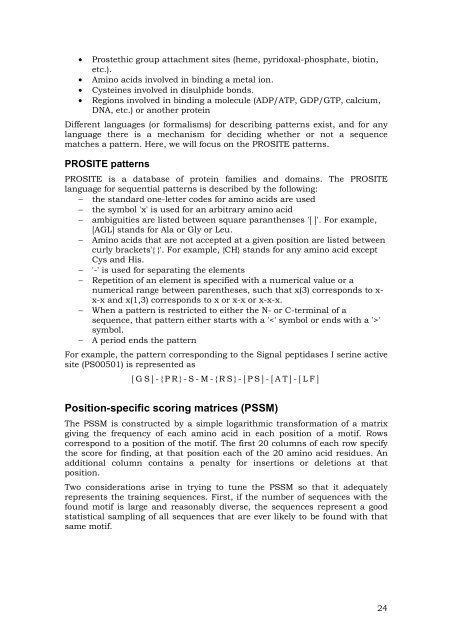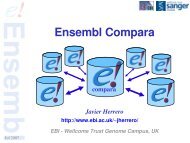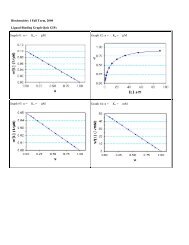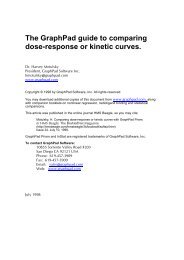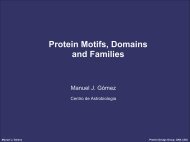Practical Course on Multiple Sequence Alignment - CNB - Protein ...
Practical Course on Multiple Sequence Alignment - CNB - Protein ...
Practical Course on Multiple Sequence Alignment - CNB - Protein ...
You also want an ePaper? Increase the reach of your titles
YUMPU automatically turns print PDFs into web optimized ePapers that Google loves.
• Prostethic group attachment sites (heme, pyridoxal-phosphate, biotin,<br />
etc.).<br />
• Amino acids involved in binding a metal i<strong>on</strong>.<br />
• Cysteines involved in disulphide b<strong>on</strong>ds.<br />
• Regi<strong>on</strong>s involved in binding a molecule (ADP/ATP, GDP/GTP, calcium,<br />
DNA, etc.) or another protein<br />
Different languages (or formalisms) for describing patterns exist, and for any<br />
language there is a mechanism for deciding whether or not a sequence<br />
matches a pattern. Here, we will focus <strong>on</strong> the PROSITE patterns.<br />
PROSITE patterns<br />
PROSITE is a database of protein families and domains. The PROSITE<br />
language for sequential patterns is described by the following:<br />
− the standard <strong>on</strong>e-letter codes for amino acids are used<br />
− the symbol 'x' is used for an arbitrary amino acid<br />
− ambiguities are listed between square paranthenses '[ ]'. For example,<br />
[AGL] stands for Ala or Gly or Leu.<br />
− Amino acids that are not accepted at a given positi<strong>on</strong> are listed between<br />
curly brackets'{ }'. For example, {CH} stands for any amino acid except<br />
Cys and His.<br />
− '-' is used for separating the elements<br />
− Repetiti<strong>on</strong> of an element is specified with a numerical value or a<br />
numerical range between parentheses, such that x(3) corresp<strong>on</strong>ds to x-<br />
x-x and x(1,3) corresp<strong>on</strong>ds to x or x-x or x-x-x.<br />
− When a pattern is restricted to either the N- or C-terminal of a<br />
sequence, that pattern either starts with a ''<br />
symbol.<br />
− A period ends the pattern<br />
For example, the pattern corresp<strong>on</strong>ding to the Signal peptidases I serine active<br />
site (PS00501) is represented as<br />
[ G S ] - { P R } - S - M - { R S } - [ P S ] - [ A T ] - [ L F ]<br />
Positi<strong>on</strong>-specific scoring matrices (PSSM)<br />
The PSSM is c<strong>on</strong>structed by a simple logarithmic transformati<strong>on</strong> of a matrix<br />
giving the frequency of each amino acid in each positi<strong>on</strong> of a motif. Rows<br />
corresp<strong>on</strong>d to a positi<strong>on</strong> of the motif. The first 20 columns of each row specify<br />
the score for finding, at that positi<strong>on</strong> each of the 20 amino acid residues. An<br />
additi<strong>on</strong>al column c<strong>on</strong>tains a penalty for inserti<strong>on</strong>s or deleti<strong>on</strong>s at that<br />
positi<strong>on</strong>.<br />
Two c<strong>on</strong>siderati<strong>on</strong>s arise in trying to tune the PSSM so that it adequately<br />
represents the training sequences. First, if the number of sequences with the<br />
found motif is large and reas<strong>on</strong>ably diverse, the sequences represent a good<br />
statistical sampling of all sequences that are ever likely to be found with that<br />
same motif.<br />
24


